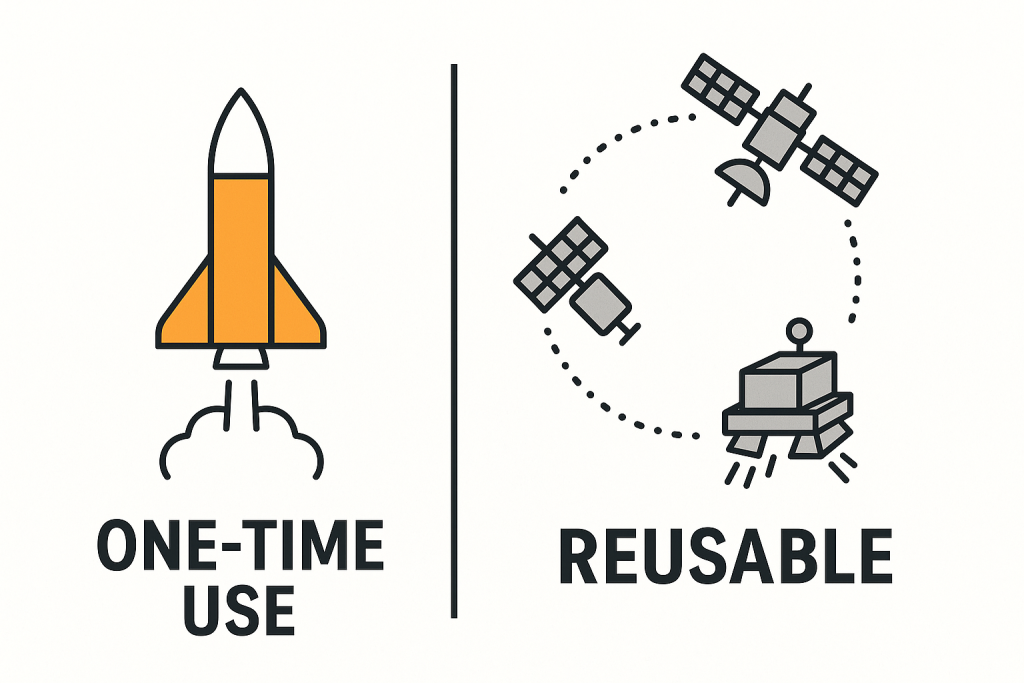Why scalable, reusable systems are replacing one-shot missions in space
The Old Model: One Launch, One Mission
For decades, space missions followed a single-use mindset.
Traditionally, each space mission was a standalone event:
- Launch a satellite
- Complete its job
- Wait for failure or end-of-life
- Repeat the process from scratch
This model made sense when access to space was rare and expensive. But today, it’s being replaced by a new, infrastructure-first strategy—one that’s sustainable, serviceable, and built to scale.
What’s Changing? The Rise of Orbital Infrastructure
Space is becoming a platform, not just a destination.
Key innovations are transforming how missions are planned:
- Reusable launch vehicles (e.g., SpaceX Falcon 9, Starship)
- On-orbit servicing platforms (e.g., Northrop MEV, Astroscale)
- Fuel depots and space tugs (e.g., Orbit Fab, Impulse Space)
- Modular space stations and habitats (e.g., Axiom Station, Starlab)
Together, these systems turn space from a “use once and leave” environment into a functioning ecosystem.
From Mission to Maintenance: What Reusability Enables
1. Infrastructure-Led Planning
Instead of designing every new mission from scratch, planners now plug into persistent assets.
Reusable infrastructure allows:
- Staging and resupply from depots or stations
- Servicing of satellites without deorbiting
- Flexible logistics using space tugs and autonomous vehicles
This model mimics terrestrial logistics—with trucks, depots, and refueling stops.
2. Scalable Presence
Reusability means one launch can support multiple missions over time.
For example:
- A single satellite may receive multiple upgrades and fuel top-offs
- A tug can service dozens of customers on a scheduled route
- A station can host rotating missions from different countries or clients
This creates efficiency through accumulation, not duplication.
3. Cost Compression and Risk Reduction
Infrastructure smooths risk and lowers entry barriers.
Benefits include:
- Fewer launches needed, reducing expense and emissions
- Mid-mission course corrections, made possible by servicing
- Decreased payload redundancy, since parts can be replaced, not duplicated
Reusable infrastructure brings resilience and adaptability—traits essential for long-term planning.
Industries and Governments Already Adapting
| Sector | How It’s Evolving |
|---|---|
| Commercial Satellites | Switching to modular, serviceable designs |
| National Defense | Investing in fuel depots, rapid launch logistics |
| Exploration Missions | Incorporating in-orbit assembly and refueling |
| Space Tourism | Anchoring flights to orbital stations or gateways |
The common thread? Designing for reuse, resupply, and long-term orbit operations.
Why This Matters for the Next Decade
One-shot missions are brittle. Infrastructure is scalable.
As global space activity grows, we face limits on:
- Launch frequency
- Orbital debris
- Mission overlap and inefficiency
Reusable infrastructure offers a path forward—from disconnected events to integrated systems.
The future of space will resemble aviation or shipping: scheduled, serviceable, and sustained.
Conclusion: Build It to Last, Not Just to Launch
The era of launching, abandoning, and starting over is ending. In its place, we’re seeing the rise of a new model—one where missions are layered onto a durable, extensible foundation.
That foundation is orbital infrastructure: reusable, modular, and designed for the long haul.
The real race in space isn’t who can launch first—it’s who can build a system that never has to start over.


